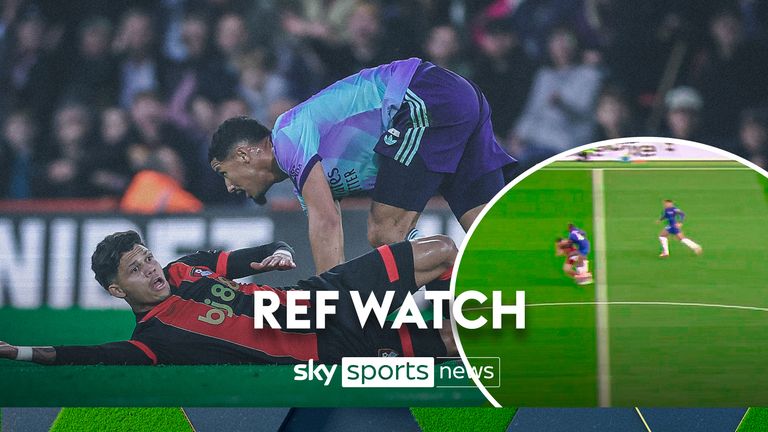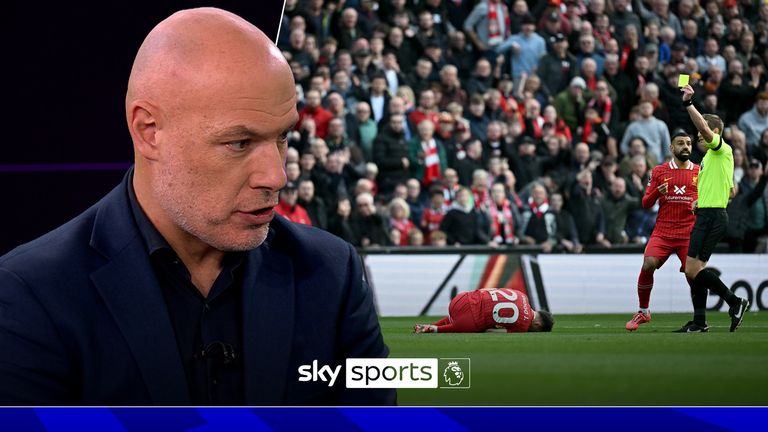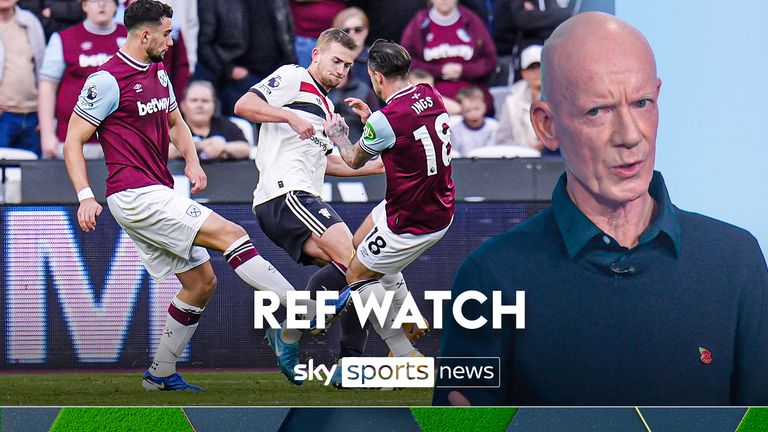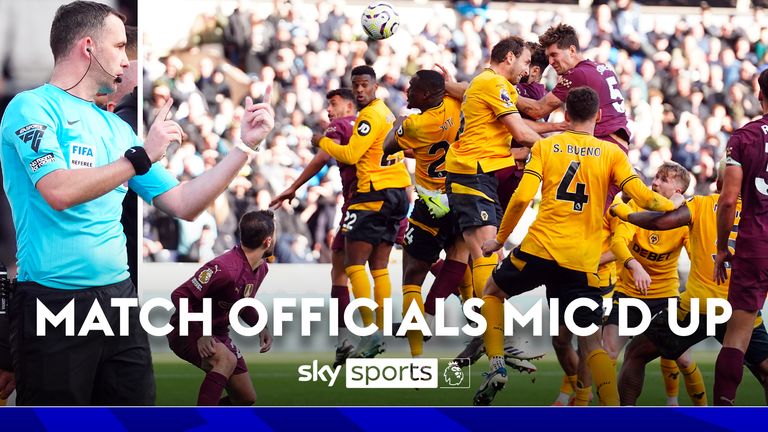[ad_1]
PGMOL chief Howard Webb believes it was the correct decision to upgrade William Saliba’s yellow card to a red during Arsenal’s 2-0 defeat at Bournemouth last month.
The French defender was shown a straight red card for pulling down Bournemouth striker Evanilson in the first half of the Gunners’ defeat at the Vitality Stadium. The call was upgraded from a yellow card after VAR Jarred Gillett recommended Robert Jones review the decision on-field.
Saliba was initially booked for his last-man foul near the centre circle following Leandro Trossard’s poor pass, but referee Jones changed his decision to a red following a VAR check as Arsenal were reduced to 10 men for the third time this season.
WHAT THE OFFICIALS SAID:
Assistant referee: For me, the covering defender is too far away but he’s not in control of the ball. It probably feels more yellow than red. He has a lot of work to do.
Fourth official: I agree, I agree with that.
Referee: I’m thinking caution because of Ben White. He is the covering man and he’s very far out, so on-field decision is yellow card, William Saliba.
VAR: Checking decision for possible DOGSO (denying a goalscoring opportunity). The goalkeeper is backing away, White is too far away from the ball.
I think it’s DOGSO, clear evidence of DOGSO. He’s goal-side and the ball is only going to get possession from the attacker. I’m going to recommend an on-field review for potential DOGSO.
The considerations are it is a clear flour, the distance Ben White is from the ball, and I’m going to show you another angle to show the goalkeeper’s movement.
Referee: I’m with you, Jarred. I completely agree, Ben White is further away than we expected. It’s a red card.
WEBB’S VERDICT:
I do believe that the offence committed by William Saliba in this situation did deny Evanilson an obvious goalscoring opportunity and therefore the referee’s call to brandish a yellow card on the field was wrong.
There are four criteria for DOGSO: The first is the direction of play… is it going towards or away from the goal? Secondly, it’s the position and location of defenders. Are they going to be able to impact a goalscoring opportunity? The third one is how likely it is the attacker is going to get control of the ball, and then the fourth one is the distance from goal.
Quite often you have to look at all of them together and, usually, you need all four of them to be in place to confirm that a DOGSO has happened.
Should Tosin have been sent off for Chelsea on same principle?
INCIDENT: Chelsea centre-back Tosin Adarabioyo was only shown a yellow card for a similar incident when he brought down Diogo Jota during Chelsea’s 2-1 defeat at Liverpool. A yellow card was given.
WHAT THE OFFICIALS SAID:
Referee: Foul and a yellow.
Fourth official: Pulls him back, mate.
Assistant referee: Yellow.
Referee: Tosin, yellow. There’s a man there.
VAR: Too much distance, too much doubt.
VAR: I’m confirming, on-field decision of yellow card. Clearly too much doubt for DOGSO.
WEBB’S VERDICT:
The two situations have been compared as they happened in the same match round. It often happens. Again, in this situation, the on-field decision was a yellow card for Tosin stopping a promising attack.
The referee felt this fell short of being DOGSO because the ball is arcing away to the right.
With Saliba, the ball is going towards the centre. Another key aspect is, for me, that Levi Colwill is pretty close by. It’s happened high up the field and Colwill would undoubtedly have been able to impact this situation.
I agree with a yellow card in this situation.
Were West Ham right to be awarded a penalty against Man Utd?
INCIDENT: Manchester United defender Matthijs de Ligt made contact with West Ham forward Danny Ings but David Coote initially waved play on. After it was suggested he go to the monitor by Michael Oliver on VAR, Coote awarded a penalty to West Ham which Jarrod Bowen went on to score.
WHAT THE OFFICIALS SAID:
Referee: No, no, no.
VAR: Just checking possible penalty… I think this is a penalty. De Ligt into the foot. Lower leg, yeah. He misses the ball and the contact with the leg.
AVAR: I think De Ligt doesn’t make contact with the ball. I agree.
VAR: Cootey, I’m going to recommend an on-field review for a possible penalty.
Referee: So we’ve got knee-to-knee contact.
VAR: Yeah, lower leg contact from De Ligt onto Danny Ings with no contact on the ball from De Ligt.
Referee: We’ve got knee-to-knee contact but does Ings have control of the ball at any point?
VAR: He does not, he’s moving into the way of the ball and De Ligt comes into contact with Ings.
Referee: So we’ve got more contact by De Ligt than we have for Ings. We’re giving a penalty, no further action.
WEBB’S VERDICT:
I thought it was a misread by the VAR Michael Oliver. A VAR who is normally very talented and reliable. He got uber-focused in this situation with De Ligt’s leg.
His leg coming through onto Danny Ings, not making any contact with the ball. The VAR sees that as a clear foul but I don’t think he should get involved.
I think this is a situation where you leave the on-field decision as it is, probably whichever way it’s called. VAR got too focused on the swinging leg from De Ligt.
Referees are told they are within their rights to stick to their original decision but of course, when they are sent to the screen, they are going because the VAR has identified what they perceive is an error. That judgment might be wrong, as it was in this case. They need to still look at the monitor with fresh eyes and make a call.
Was VAR right to award Man City a late winner vs Wolves?
INCIDENT: John Stones headed in an injury-time winner for Man City at Wolves. It was originally disallowed for offside, with Bernardo Silva judged to be in the line of sight of goalkeeper Jose Sa. However, a VAR review led to a pitchside check and the goal eventually was given.
WHAT THE OFFICIALS SAID:
Referee: Silva is in front of the goalie.
VAR: So, the only concern I’ve got here is in line of vision offside.
Assistant referee: When the ball comes in, he [Silva] moves to the right-hand side.
Referee: So you’re happy he’s not offside?
Assistant referee: He is in an offside position, that’s all I can tell you. I’m going to go with offside.
Referee: On-field decision is offside.
VAR: Delay, delay, checking on-field decision of offside. So run it through… that’s not offside, is it?
He’s not in line of vision. He’s not attempting to play a ball that’s close to him. He’s not challenging the opponent… Kav [referee Chris Kavanagh] I’m going to recommend an on-field review for a possible goal.
Bernardo Silva is in the six-yard box, he’s definitely not in the line of vision. He’s not challenging, he’s not making a movement to distract and he’s not attempted to play a ball that’s close.
Referee: My opinion is no interference whatsoever, on-field decision is goal now.
WEBB’S VERDICT:
It was disallowed in real-time. There was a big confusion over whether it had been disallowed initially.
The on-field decision determined that Bernardo Silva had committed an offside offence when the ball was headed forward by John Stones.
From that moment, Silva’s position becomes relevant. But he hasn’t committed an offside offence as he hasn’t impacted the goalkeeper’s movement. When the VAR looked at the replays, he could see that no offside offence had been committed and so a goal could be awarded.
Watch Match Officials: Mic’d Up on Sky Sports Premier League on Tuesday at 7pm, and catch up on SkySports.com, the Sky Sports App and Sky Sports social channels.
[ad_2]
Source link







